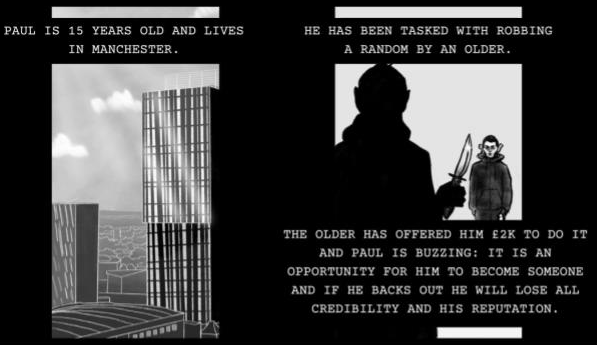Co-created serious youth violence animation
Dr Paul Gray
Monday, October 25, 2021
Researchers at the Manchester Centre for Youth Studies have co-created - with justice-involved children - a short animation to help facilitate discussion around adverse childhood experiences and serious youth violence.
Research has consistently found that justice-involved children have childhoods disproportionally characterised by adverse childhood experiences (ACEs). ACEs are potentially traumatic events that occur in childhood and can include, for example: physical abuse and/or neglect, emotional abuse and/or neglect, sexual abuse, witnessing domestic violence, parental separation or loss, substance misuse within the family, mental illness within the family, or having a family member in prison.


While not everyone who experiences ACEs has a negative outcome, ACEs have been shown to have lasting negative effects on health, well-being, and opportunity. ACEs have also been found to be strongly associated with a range of problematic behaviours including aggression and violence.
With this in mind, researchers from the Manchester Centre for Youth Studies have undertaken a study to investigate the relationship between ACEs and SYV.
The study found that, out of a sample of 200 justice-involved children, two thirds were assessed as having experienced five or more of the 10 ACEs listed above, with over a fifth experiencing eight or more. The most commonly identified ACEs, experienced by over two thirds of the children, were ‘parental separation or loss’ and ‘substance misuse within the family’, with over three fifths growing up ‘witnessing domestic violence’. Exactly three quarters of the assessed children had experienced some form of abuse, and over seven tenths had experienced some form of neglect.


The relationship between ACEs and SYV
Interviews with youth justice professionals highlighted the detrimental impact that ACEs can have on children’s thought processes and emotional well-being, often resulting in an increased tendency to respond to confrontational situations through anger and/or aggression. This was often exacerbated by the domestic violence that many of the children had witnessed and/or experienced as victims.
Related to this, professionals talked of children being predominantly in the fight survival response to keep themselves feeling safe, both in the home and on the streets. Indeed, a number of those interviewed felt that the need to feel safe was directly linked to children carrying knives or other weapons.
Youth justice professionals also talked of ACEs resulting in children seeking out opportunities, or behaving in particular ways, that gained them praise and/or acceptance from others. Not only because this might have been largely absent in their home lives, but also as a direct response to the negative feelings and emotions that ACEs can engender. Furthermore, it was felt that the desire to feel belonging and acceptance made children with multiple ACEs particularly susceptible to CCE.


Participatory workshops
To explore children’s own articulations of the causes and drivers of SYV, and to develop a more in-depth understanding of the relationship between ACEs and SYV, the study adopted a participatory approach with justice-involved children. A series of workshops were convened involving justice-involved children, creative therapists, and the research team.
Given the sensitive nature of the topic and the challenges associated with getting children to discuss ACEs, the decision was made to use storytelling techniques in the workshops to elicit discussion around ACEs and SYV. Storytelling was particularly appropriate as it allowed the children to create fictional, third-person accounts and provide metaphors rather than a description of actual lived events.
The participatory workshops resulted in a short co-created animation. The animation presents two fictional stories that were developed by the children during the workshops. The stories highlight the impact of ACEs, some of the causes and drivers of SYV, and the nature of support that children who have experienced ACEs might need. The aim is for the animation - which is also available in a comic book format - to be a helpful resource that can be drawn upon by professionals when discussing ACEs and/or SYV with the children with whom they work.
Dr Paul Gray is a reader in criminology at Manchester Metropolitan University, and deputy director of the Manchester Centre for Youth Studies




